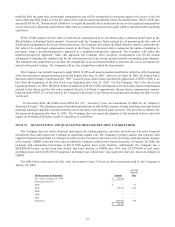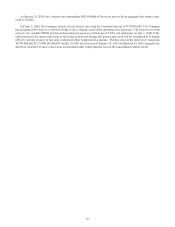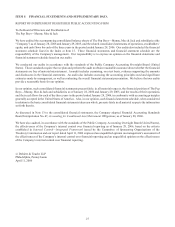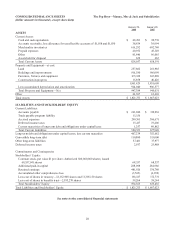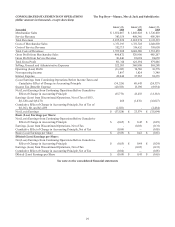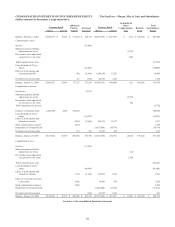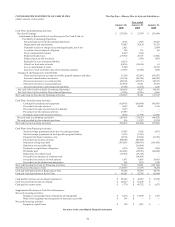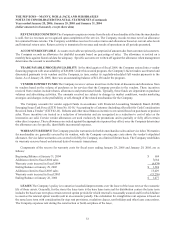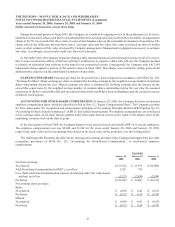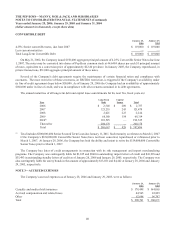Pep Boys 2005 Annual Report Download - page 38
Download and view the complete annual report
Please find page 38 of the 2005 Pep Boys annual report below. You can navigate through the pages in the report by either clicking on the pages listed below, or by using the keyword search tool below to find specific information within the annual report.
33
THE PEP BOYS—MANNY, MOE & JACK AND SUBSIDIARIES
NOTES TO CONSOLIDATED FINANCIAL STATEMENTS (Continued)
Years ended January 28, 2006, January 29, 2005 and January 31, 2004
(dollar amounts in thousands, except share data)
REVENUE RECOGNITION The Company recognizes revenue from the sale of merchandise at the time the merchandise
is sold. Service revenues are recognized upon completion of the service. The Company records revenue net of an allowance
for estimated future returns. The Company establishes reserves for sales returns and allowances based on current sales levels
and historical return rates. Return activity is immaterial to revenue and results of operations in all periods presented.
ACCOUNTS RECEIVABLE Accounts receivable are primarily comprised of amounts due from commercial customers.
The Company records an allowance for doubtful accounts based on percentage of sales. The allowance is revised on a
monthly basis against historical data for adequacy. Specific accounts are written off against the allowance when management
determines the account is uncollectible.
TRADE PAYABLE PROGRAM LIABILITY In the third quarter of fiscal 2004, the Company entered into a vendor
financing program with an availability of $20,000. Under this secured program, the Company’s factor makes accelerated and
discounted payments to its vendors and the Company, in turn, makes its regularly-scheduled full vendor payments to the
factor. As of January 28, 2006, there was an outstanding balance of $11,156 under the program.
VENDOR SUPPORT FUNDS The Company receives various incentives in the form of discounts and allowances from
its vendors based on the volume of purchases or for services that the Company provides to the vendors. These incentives
received from vendors include rebates, allowances and promotional funds. Typically, these funds are dependent on purchase
volumes and advertising activities. The amounts received are subject to changes in market conditions, vendor marketing
strategies and changes in the profitability or sell-through of the related merchandise for the Company.
The Company accounts for vendor support funds in accordance with Financial Accounting Standards Board (FASB)
Emerging Issues Task Force (EITF) Issue No. 02-16, “Accounting by a Customer (Including a Reseller) for Cash Consideration
Received from a Vendor” (EITF 02-16). Rebates and other miscellaneous incentives are earned based on purchases or product
sales. These incentives are treated as a reduction of inventories and are recognized as a reduction to cost of sales as the
inventories are sold. Certain vendor allowances are used exclusively for promotions and to partially or fully offset certain
other direct expenses. These allowances are netted against the appropriate expenses they offset, once the Company determines
the allowances are for specific, identifiable incremental expenses.
WARRANTY RESERVE The Company provides warranties for both its merchandise sales and service labor. Warranties
for merchandise are generally covered by its vendors, with the Company covering any costs above the vendor’s stipulated
allowance. Service labor warranties are covered in full by the Company on a limited lifetime basis. The Company establishes
its warranty reserves based on historical data of warranty transactions.
Components of the reserve for warranty costs for fiscal years ending January 28, 2006 and January 29, 2005, are as
follows:
Beginning Balance at January 31, 2004 $ 614
Additions related to fiscal 2004 sales 7,684
Warranty costs incurred in fiscal 2004 (6,974)
Ending Balance at January 29, 2005 $ 1,324
Additions related to fiscal 2005 sales 13,429
Warranty costs incurred in fiscal 2005 (13,276)
Ending Balance at January 28, 2006 $ 1,477
LEASES The Company’s policy is to amortize leasehold improvements over the lesser of the lease term or the economic
life of those assets. Generally, for the stores the lease term is the base lease term and for distribution centers the lease term
includes the base lease term plus certain renewal option periods for which renewal is reasonably assured and for which failure
to exercise the renewal option would result in an economic penalty. The calculation for straight-line rent expense is based on
the same lease term with consideration for step rent provisions, escalation clauses, rent holidays and other lease concessions.
The Company expenses rent during the construction or build-out phase of the lease.




